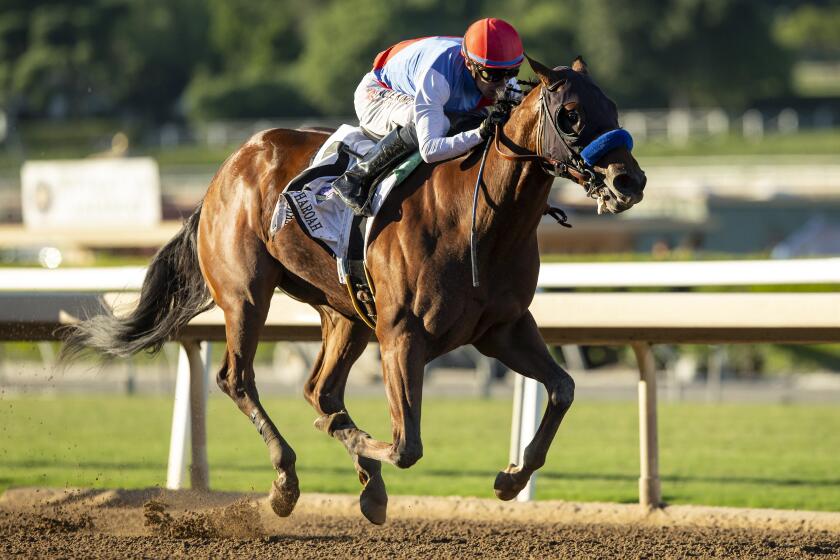RUNNING WITH THE ZEBRAS : Referees: A game in the life of a football quintet provides a look at the interaction among the men in striped shirts.
The receiver dives fully extended along the sideline and comes up with the ball at the goal line. Catch or trap? In or out of bounds? Touchdown or first down?
Correct answers lie in teamwork and perfect coverage--by the officials.
This play occurred last Thursday night in a Marmonte League football game between Thousand Oaks and Camarillo highs. Field judge Joe Garces dashed up the sideline a few yards behind the receiver, Jeff Watts of Thousand Oaks. Back judge Bob Barrett hustled to the goal line between the hash marks.
From his vantage, Garces saw Watts’ arms slip under the ball for a catch less than a yard inbounds. From his angle, Barrett ascertained that Watts had crossed the goal line. The officials momentarily made eye contact, then their arms shot skyward: Touchdown.
To most fans attending the game (won by host Thousand Oaks, 28-7), the five-man officiating crew was barely noticeable. And that is exactly the way the officials prefer it. But numerous details, many almost imperceptible, contributed to a job well-done.
Not that anyone told them they had called a good game: Officiating is the wrong racket in which to find strokes. The work is thankless, yet it can be richly rewarding. Officiating enables grown men to participate in a kids’ game.
“You’ve got the best seat in the house,” Barrett said. “A good official is a football fan. You have to love the game.”
Lots of people enjoy football. Few stuff their pockets full of yellow flags, don a striped shirt and take the field.
How do high school officials operate? And what makes an effective crew?
To gain insight, an evening was spent running with the zebras.
In the dressing room an hour before the game, referee and crew chief John Stoney leads a painstaking discussion of officiating mechanics and unusual situations. They might whistle while they work, but officials dread being caught unprepared. Reviewing obscure rules, they sound like fraternity brothers cramming for an exam.
And a fraternity it is. Each official--Stoney, Barrett, Garces, umpire Bob Guillen and head linesman Jerry Nelson--has at least 20 years experience in the Channel Coast Officials Assn., which supplies high school officials to games in all sports from Calabasas to Santa Barbara. The association also supplies college officials to the Western State and Western Football conferences.
Officiating, of course, is not a primary source of income--a high school game pays $45. Stoney is athletic director at San Marcos High; Guillen is a corn chips salesman; Garces is a civil service administrator at the Point Mugu naval station; Nelson is a teacher at the Camp Kilpatrick school for juvenile offenders in Malibu; Barrett owns a stationery store.
Drawn from various walks of life, they are kindred spirits. While dressing Thursday, they offer friendly tips to the crew that had just completed the junior-varsity game and remind one another about the association’s upcoming barbecue.
“Officials are supportive of one another,” Nelson said. “We take tests, we study the rules. But the primary way we learn is by watching fellow officials.”
Earlier, both coaches informed Stoney and Guillen of trick plays the teams might use--reverses, double reverses, halfback passes, fake punts and the like. Over a coach’s boisterous speech before the Camarillo team in the adjoining locker room, Stoney relays the information to the rest of his crew, saying: “We don’t want to get fooled by weird stuff.”
Before they head for the field, Guillen says, “Do we have a coin, Mr. Stoney?” The referee taps his pocket, nods and says, “Let’s go.”
The officials are greeted cordially by team captains during the coin flip, but less than two minutes into the game smiles turn to frowns.
Camarillo runs a play-action pass down the left sideline, directly in front of the Scorpion bench. As the pass sails out of bounds and out of reach, a Thousand Oaks defensive back unloads on the receiver.
No flag is thrown; the pass was judged uncatchable by Nelson and Barrett, the officials closest to the play.
Camarillo fans and coaches howl in disbelief. A Camarillo assistant angrily gestures, as if to throw a flag himself. “Where’s the flag?” he demands.
Nelson replies, “We’ve got two guys watching the play,” and turns away. End of discussion. Later, Nelson explains that an official should not prolong a dispute: “I just said enough to relax the situation. You don’t want to say antagonizing things. You don’t ignore coaches, but we don’t coach, we don’t hold clinics, we just call the game.”
A few minutes later, Camarillo punts. Two Thousand Oaks players mildly lean into the punter after the ball is kicked. The punter, McLane Hansen, rolls on the field, turns up his palms and looks to Stoney in dismay. The referee slowly shakes his head--the act is not convincing.
On the ensuing possession, Thousand Oaks executes a screen pass to fullback Greg Buchanan, who dashes 26 yards down the right sideline in front of the Lancer bench.
Garces spots a clip, however, and throws a flag. Most of the gain is nullified. Thousand Oaks coaches react as if someone had robbed their homes. “No way you can call that a clip,” Coach Bob Richards tells Garces. “Hey, he turned on him. C’mon.”
Garces picks up the flag without a word. Later, he smiles and says, “(The blocker) pulled back as if he didn’t touch him. But he did.”
Each official has a predetermined role in enforcing the penalty.
Garces stands at the point of the infraction. Barrett stands where the ball should be placed after the penalty is marked off. Nelson makes sure the chains are set properly and that the down marker has not changed.
Guillen takes the ball and steps off the yardage. Stoney signals that a clip has been called, and, once the chains are set, starts the clock by making a windmill motion with his arms.
When Stoney informs the Camarillo team captain of the clip, he makes it clear that the team ought to accept the penalty. “We don’t let him mess up on accepting or refusing an obvious penalty,” Stoney says. “We say, ‘You want this.’ ”
Several points emphasized in the pregame discussion also come into play in the first half.
Because Camarillo runs a wishbone that utilizes fake handoffs, Stoney reminded the crew to make certain a back is carrying the ball before blowing a whistle when he is tackled. “Be slow with the whistles,” he warned.
On a dive up the middle, Scorpion fullback Tag Johnson is hit and appears to go down. He barely keeps his feet by using his free hand to crawl, however, and gains an additional four yards. No whistles are heard until Johnson is indeed tackled.
Also, a primary duty of flank officials--Nelson and Garces, in this case--is to mark the forward progress of ballcarriers. Stationed near the sideline, they have a better angle than the other three officials, who stand near the middle of the field. This is especially crucial on running plays near the goal line, when the field judge or head linesman should be the first to signal touchdown.
Thousand Oaks scores on a five-yard run by Cory Bowen directly at the feet of Guillen, stationed behind the defensive line, but Guillen waits until Nelson raises his arms before signaling touchdown himself.
With less than two minutes to play in the half, Thousand Oaks employs a hurry-up offense. Although the players move frantically to conserve precious seconds, the officials proceed methodically.
“If there is anything I’ve learned from the college level, it’s to slow down our mechanics,” Barrett had said during the pregame discussion. “A team might be in a speed-up offense, but we still control the tempo, we can’t get caught up in their rush.”
The Lancers need only 55 seconds to score, and they take a 21-7 lead after the point-after kick curls inches inside the left upright. Barrett, standing directly beneath the upright, watches the ball pass through, then steps forward with his arms raised.
“The entire ball must pass entirely inside the upright,” he explained later.
The teams leave the field for halftime and Barrett, who as back judge is in charge of the game clock, tells the clock operator to begin running off 15 minutes--the duration of halftime. When the clock reaches zero, an additional three minutes tick off to allow the teams to warm up for the second half.
“We don’t care if (the teams) actually warm up,” Stoney said. “That’s the coach’s responsibility. But if a kid gets hurt on the first play, they can’t say we didn’t give them time to warm up.”
Emotions heat up in the third quarter as Camarillo tries in vain to score. Eric Bateman of Camarillo and David Acosta of Thousand Oaks continue hitting after a play is blown dead. They shove each other and words are exchanged. From 10 yards away, Guillen screams to them, “Hey, hey ,” the players part and Guillen yells, “Thank you.”
He could have been speaking for the entire crew. The game is remarkably smooth from an officiating standpoint. Only three penalties are called--the one for clipping and two for false starts by offensive linemen.
Crew members have 109 years of officiating experience among them, yet none has been involved in a penalty-free game. As high school football goes, this evening has been easy.
The clock expires and Stoney holds up the ball to indicate the game is over. The officials leave the field in the same manner that they arrived--together and without dallying. They came, they called, they called it a night.
More to Read
Get our high school sports newsletter
Prep Rally is devoted to the SoCal high school sports experience, bringing you scores, stories and a behind-the-scenes look at what makes prep sports so popular.
You may occasionally receive promotional content from the Los Angeles Times.







